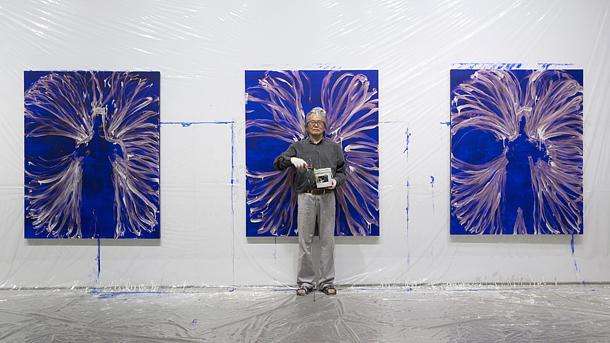Performance artist features work at Leeahn

Lee Kun-yong in front of his work at Leeahn Gallery in Seoul. [YONHAP]
In another performance, he stood in front of a canvas made of wood veneer, with his back to it. Unable to see what he was creating, he drew on the canvas as much as his limited body movements allowed him to.
For a young Lee, overcoming the limitations of a flat, two-dimensional canvas was one of the most pressing issues he faced as an artist. Equally important was raising awareness of the importance of an artist’s body as an artistic medium.
In 2014, the National Museum of Modern and Contemporary Art (MMCA) of Korea held a retrospective of the country’s first-generation performance and conceptual artist. At the exhibition showing his oeuvre, which spans 40 years, the artist re-enacted “In Snail’s Gallop,” his first work, which he performed during the Sao Paulo Biennale in 1979.
Squatting at the corner of the exhibition hall, he drew line after line and, at the same time, erased parts of the just-drawn lines using his feet.
One of the country’s pioneers of the avant-garde art movements back in the 1970s, the 75-year-old artist is still actively practicing his lifelong philosophy - that art is defined by an artist’s physical movements and that it is the embodiment and reflection of a social, political atmosphere.
Living through the dark patches of Korean modern history meant that freedom of expression was fully guaranteed only when it was helpful in justifying the unjustifiable by the authoritarian government.
“In 1975, I was taken to the National Intelligence Service,” he said during an interview with Yonhap News Agency at Seoul’s Leeahn Gallery on Monday. “One of the officers (intentionally) stepped on my thighs while investigating me. I suffered from the injuries for years to come.”
He added, “He was trying to destroy my thoughts by harming my body. Since then, I’ve become more self-assured about physically expressing my thoughts, even if it involves the simplest act, like drawing a line.”
The artist opened a solo exhibition at the gallery on Thursday, which will run until July 29, with about 21 pieces of art, including paintings and a video of his performance. On display are some paintings he created at the gallery earlier this month.
According to the gallery, the exhibition is designed to throw light on his painting series, such as “Body Scape” and “The Method of Drawing,” which have been seen more as a by-product or a record of his performances than as individual art pieces.
His paintings are not a painting in the traditional sense of the word.
He paints behind a canvas, arms stretched over the front of it. When he does stand in front, he doesn’t look at what he is working on.
Only his physical movements, like swinging his arms or dragging his feet, are there to leave a trace of his artistic activities.
In every aspect of social life, direct interaction with others is the most democratic way of doing things, he said, adding that the same goes with the way of doing art.
“The primal purpose of art is to communicate with contemporaries. When art stops reflecting the era,” he said, “it is destined to disappear.”
Yonhap










with the Korea JoongAng Daily
To write comments, please log in to one of the accounts.
Standards Board Policy (0/250자)